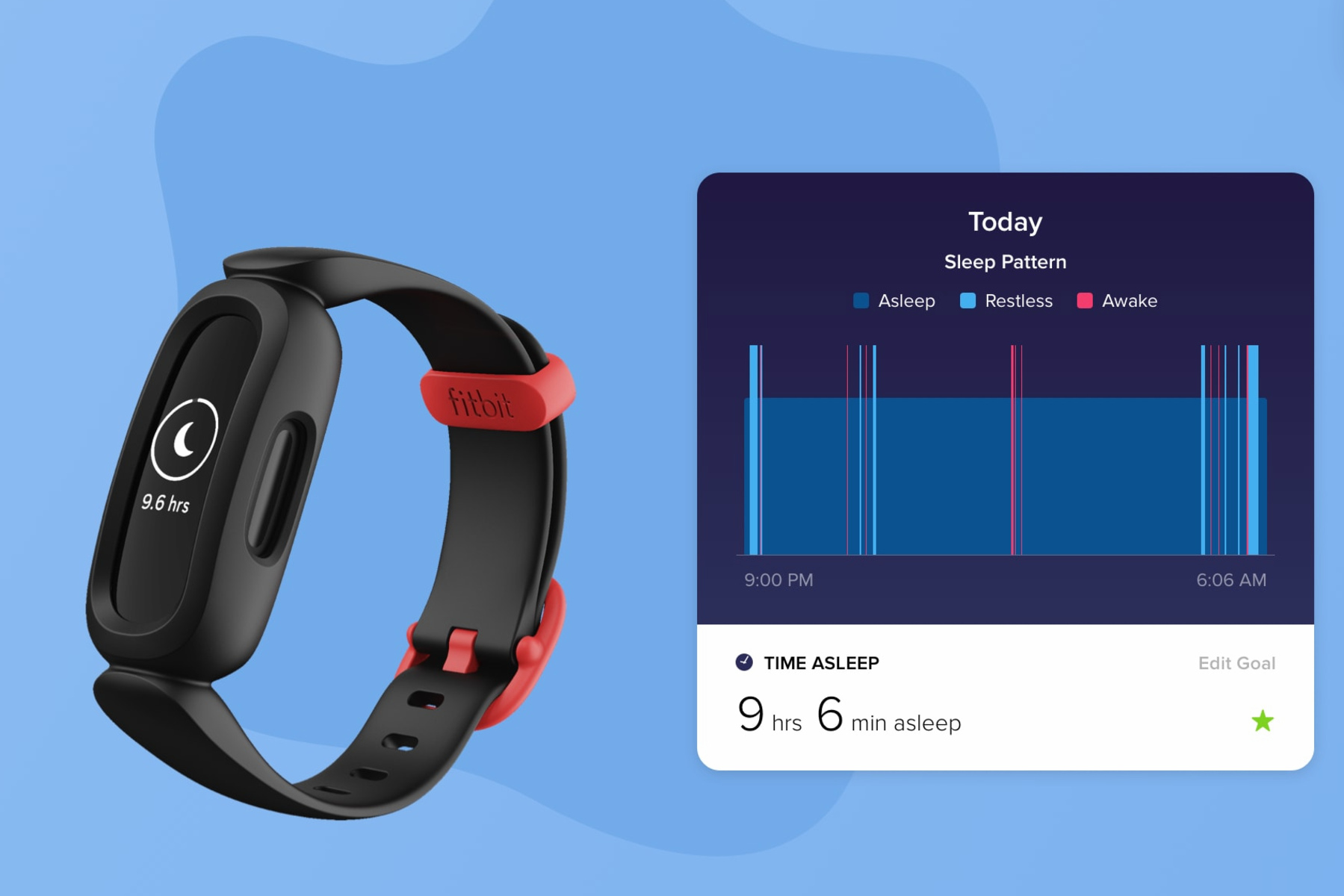Introduction
Sleep is an essential aspect of our daily lives, contributing significantly to our overall well-being and quality of life. The patterns and quality of our sleep have a profound impact on our physical and mental health, cognitive function, and emotional well-being. In recent years, the advent of wearable technology, such as Fitbit devices, has provided individuals with the means to gain valuable insights into their sleep patterns.
Understanding and analyzing these sleep patterns can offer invaluable information about the duration, quality, and regularity of our sleep. This knowledge can empower individuals to make informed decisions and lifestyle adjustments to enhance their sleep quality and overall health.
The human sleep cycle is a complex and dynamic process, characterized by distinct stages that play a crucial role in promoting physical restoration, mental rejuvenation, and emotional balance. By delving into the intricacies of these sleep stages and patterns, we can gain a deeper understanding of the factors that influence our sleep and the significance of achieving a healthy and consistent sleep routine.
In this article, we will explore the various stages of sleep, delve into the characteristics of normal sleep patterns, and examine the factors that can impact these patterns. Furthermore, we will highlight the importance of monitoring and analyzing sleep patterns using wearable technology, such as Fitbit devices, to optimize sleep quality and overall well-being.
As we embark on this exploration of sleep patterns and their significance, we will unravel the mysteries of our nightly journeys and uncover the profound impact of quality sleep on our daily lives. Join us in this enlightening journey as we unravel the secrets of a good night's rest and its transformative power on our health and vitality.
The Stages of Sleep
Sleep is a complex and dynamic process that involves distinct stages, each with unique characteristics and functions. These stages are essential for physical restoration, cognitive processing, and overall well-being. The sleep cycle consists of two main types of sleep: rapid eye movement (REM) sleep and non-rapid eye movement (NREM) sleep, which are further divided into specific stages.
Non-Rapid Eye Movement (NREM) Sleep
Stage 1: Transition to Sleep
This initial stage marks the transition from wakefulness to sleep. It is a brief period lasting only a few minutes, during which individuals may experience drowsiness and a gradual decrease in awareness of their surroundings. Muscle activity begins to decrease, and the brain produces theta waves, indicating a shift towards sleep.
Stage 2: Light Sleep
Stage 2 is characterized by a deeper state of relaxation, with further reductions in heart rate and body temperature. Brain wave activity includes brief bursts of electrical activity known as sleep spindles and slow-wave sleep. During this stage, the body prepares for deeper sleep, and individuals are less likely to be easily awakened.
Stage 3: Deep Sleep
Also known as slow-wave sleep, stage 3 is a crucial phase for physical restoration and recovery. The brain produces slow delta waves, and muscle activity decreases significantly. This stage is essential for repairing and rejuvenating the body, promoting growth and development, and enhancing immune function.
Rapid Eye Movement (REM) Sleep
Stage 4: Dream Sleep
REM sleep is characterized by rapid eye movements, increased brain activity, and vivid dreaming. This stage is essential for cognitive processing, memory consolidation, and emotional regulation. During REM sleep, the brain is highly active, and the body experiences temporary paralysis to prevent individuals from acting out their dreams.
The sleep cycle typically progresses through these stages multiple times throughout the night, with REM sleep becoming longer and more prevalent towards the latter part of the night. Understanding the nuances of these sleep stages provides valuable insights into the intricate mechanisms that govern our nightly rest, laying the foundation for comprehending normal sleep patterns and the factors that can influence them.
Understanding Normal Sleep Patterns
Normal sleep patterns encompass a delicate balance of the various sleep stages, reflecting a healthy and consistent rhythm of restorative rest. These patterns serve as a barometer of our overall sleep quality and can offer profound insights into our physical and mental well-being. Understanding the characteristics of normal sleep patterns is essential for evaluating the adequacy and effectiveness of our nightly rest.
A typical night's sleep begins with a transition from wakefulness to the initial stages of non-rapid eye movement (NREM) sleep. During this phase, individuals experience a gradual decrease in awareness, marking the onset of relaxation and preparatory changes in brain wave activity. This transition sets the stage for deeper sleep, leading to the subsequent stages of NREM sleep.
As the night progresses, the sleep cycle delves into the realms of light sleep, characterized by reduced heart rate and body temperature, and the emergence of sleep spindles and slow-wave sleep. This phase paves the way for deeper, more restorative sleep, essential for physical recovery and rejuvenation. The culmination of this progression is the immersion into deep sleep, also known as slow-wave sleep, where the body undergoes vital repair processes, promoting growth, immune function, and overall well-being.
Following the NREM stages, the sleep cycle transitions into rapid eye movement (REM) sleep, a phase marked by vivid dreaming, heightened brain activity, and temporary muscle paralysis. REM sleep plays a crucial role in cognitive processing, memory consolidation, and emotional regulation, contributing significantly to mental and emotional well-being. The duration and regularity of REM sleep are integral components of normal sleep patterns, reflecting the depth and restorative nature of our nightly rest.
Normal sleep patterns encompass the seamless progression through these stages, with variations in duration and intensity reflecting the individual's unique sleep architecture. Factors such as age, lifestyle, and overall health can influence the characteristics of normal sleep patterns, emphasizing the importance of personalized assessment and understanding.
By comprehending the intricacies of normal sleep patterns, individuals can gain valuable insights into the effectiveness of their sleep, identifying areas for improvement and optimization. This understanding serves as a cornerstone for enhancing sleep quality and overall well-being, empowering individuals to make informed choices and lifestyle adjustments to promote restorative and rejuvenating sleep.
Understanding normal sleep patterns provides a roadmap for evaluating and optimizing our nightly rest, unlocking the potential for enhanced physical, cognitive, and emotional vitality. It serves as a compass for navigating the complexities of sleep, guiding individuals towards a deeper appreciation of the transformative power of quality rest and the profound impact it holds on our daily lives.
Factors Affecting Sleep Patterns
A myriad of factors can significantly influence an individual's sleep patterns, shaping the duration, quality, and overall restorative nature of their nightly rest. These factors encompass a broad spectrum of physiological, psychological, environmental, and lifestyle elements, each exerting a distinct impact on the intricacies of sleep. By understanding these influential factors, individuals can gain valuable insights into the dynamics of their sleep patterns and make informed adjustments to optimize their sleep quality and overall well-being.
1. Circadian Rhythms:
The body's internal clock, governed by circadian rhythms, plays a pivotal role in regulating the sleep-wake cycle. Disruptions to these rhythms, such as irregular sleep schedules, shift work, or jet lag, can significantly impact sleep patterns, leading to difficulties in falling asleep and maintaining restful sleep throughout the night.
2. Stress and Anxiety:
Psychological factors, including stress and anxiety, can profoundly influence sleep patterns. Heightened stress levels can lead to difficulty in falling asleep, frequent awakenings during the night, and an overall reduction in sleep quality. Managing stress and cultivating relaxation techniques are essential for mitigating these effects and promoting healthier sleep patterns.
3. Environmental Factors:
The sleep environment, including ambient noise, light exposure, and room temperature, can exert a substantial influence on sleep patterns. Creating a conducive sleep environment, free from disruptive stimuli, can enhance the duration and quality of sleep, facilitating a more restorative and rejuvenating rest.
4. Lifestyle Choices:
Lifestyle factors, such as physical activity, diet, and substance use, can impact sleep patterns. Regular exercise promotes better sleep quality, while consuming stimulants like caffeine and nicotine close to bedtime can disrupt sleep. Additionally, maintaining a balanced and nutritious diet contributes to overall well-being, positively influencing sleep patterns.
5. Technology and Screen Time:
Excessive use of electronic devices and prolonged screen time, particularly before bedtime, can disrupt sleep patterns. The exposure to blue light emitted by screens can interfere with the body's natural sleep-wake cycle, leading to difficulties in falling asleep and achieving restful sleep.
6. Medical Conditions:
Underlying medical conditions, such as sleep apnea, insomnia, or restless leg syndrome, can significantly impact sleep patterns. Addressing these conditions through medical intervention and lifestyle modifications is essential for restoring healthy sleep patterns and overall well-being.
7. Age and Life Stage:
Sleep patterns evolve across different life stages, with age playing a significant role in the duration and structure of sleep. Infants and children have distinct sleep patterns compared to adolescents and adults, highlighting the influence of age on sleep architecture.
By recognizing the multifaceted nature of these factors and their impact on sleep patterns, individuals can proactively address potential disruptions and cultivate healthier sleep habits. Understanding the interplay of these influential elements empowers individuals to make informed choices and lifestyle adjustments, paving the way for enhanced sleep quality and overall well-being.
Importance of Monitoring Sleep Patterns
Monitoring sleep patterns holds profound significance in the quest for optimal health and well-being. By gaining insights into the duration, quality, and regularity of sleep, individuals can unlock a wealth of information that directly impacts their physical, cognitive, and emotional vitality. The importance of monitoring sleep patterns extends far beyond mere observation, transcending into the realm of proactive self-care and informed decision-making.
One of the primary benefits of monitoring sleep patterns is the ability to assess the overall quality of sleep. By tracking the duration of each sleep stage, including the time spent in non-rapid eye movement (NREM) and rapid eye movement (REM) sleep, individuals can gauge the restorative nature of their nightly rest. This insight is invaluable in identifying potential deficiencies in sleep architecture and addressing areas for improvement to enhance overall sleep quality.
Furthermore, monitoring sleep patterns facilitates the detection of irregularities or disturbances during sleep. This includes instances of frequent awakenings, disruptions in sleep continuity, and variations in sleep stages throughout the night. By recognizing these patterns, individuals can pinpoint potential sleep disorders, such as sleep apnea or insomnia, prompting timely intervention and treatment to restore healthy sleep patterns.
The data gathered from monitoring sleep patterns also provides a comprehensive understanding of the impact of external factors on sleep quality. By correlating sleep patterns with lifestyle choices, environmental influences, and daily routines, individuals can identify specific triggers that may disrupt their sleep. This awareness empowers individuals to make targeted adjustments, such as modifying sleep environments, adjusting bedtime routines, or addressing stressors, to optimize their sleep patterns and promote restful sleep.
Moreover, monitoring sleep patterns contributes to the cultivation of personalized sleep strategies. Armed with detailed insights into their sleep architecture, individuals can tailor their approach to sleep management, incorporating evidence-based techniques to enhance sleep quality. This may involve implementing relaxation practices, establishing consistent sleep schedules, and leveraging technology, such as sleep tracking devices, to refine their sleep habits and promote optimal rest.
Additionally, monitoring sleep patterns fosters a proactive approach to overall well-being. By recognizing the intricate interplay between sleep and health, individuals can prioritize the optimization of their sleep patterns as a fundamental pillar of self-care. This proactive stance extends beyond the realm of sleep, influencing cognitive function, emotional resilience, and physical vitality, thereby contributing to a holistic approach to wellness.
In essence, the importance of monitoring sleep patterns lies in its capacity to illuminate the nuances of sleep, offering a window into the body's nightly restoration and rejuvenation. By harnessing the insights derived from sleep monitoring, individuals can embark on a transformative journey towards enhanced sleep quality, cognitive vitality, and emotional well-being, ultimately embracing the profound impact of restorative rest on their daily lives.
Conclusion
In conclusion, the intricate tapestry of sleep patterns intricately woven throughout the night holds profound significance in shaping our physical, cognitive, and emotional well-being. The exploration of the stages of sleep, the characteristics of normal sleep patterns, and the influential factors affecting sleep has unveiled the transformative power of restorative rest. As we navigate the complexities of sleep, we unravel the profound impact of quality sleep on our daily lives.
Understanding the stages of sleep, from the initial transition to the depths of deep sleep and the immersive realm of rapid eye movement (REM) sleep, provides a roadmap for comprehending the restorative mechanisms at play during our nightly rest. These stages, each with its unique functions and significance, underscore the intricate balance required for achieving healthy and rejuvenating sleep patterns.
The characteristics of normal sleep patterns serve as a barometer of our overall sleep quality, offering insights into the adequacy and effectiveness of our nightly rest. By delving into the nuances of normal sleep patterns, individuals gain a deeper appreciation for the restorative nature of sleep and the potential for optimizing their sleep quality.
Moreover, the multifaceted factors influencing sleep patterns, including circadian rhythms, stress, lifestyle choices, and environmental influences, underscore the dynamic interplay shaping our nightly rest. By recognizing these influential elements, individuals can proactively address potential disruptions and cultivate healthier sleep habits, promoting overall well-being.
The importance of monitoring sleep patterns cannot be overstated. By gaining insights into the duration, quality, and regularity of sleep, individuals unlock a wealth of information that directly impacts their physical, cognitive, and emotional vitality. This proactive approach to self-care empowers individuals to make informed decisions and lifestyle adjustments, fostering a holistic approach to wellness.
In essence, the journey through the intricacies of sleep patterns unveils the transformative power of restorative rest. By harnessing the insights derived from understanding, monitoring, and optimizing sleep patterns, individuals embark on a transformative journey towards enhanced sleep quality, cognitive vitality, and emotional well-being. As we embrace the profound impact of restorative rest on our daily lives, we embark on a journey towards a revitalized and rejuvenated existence, empowered by the transformative power of quality sleep.
























